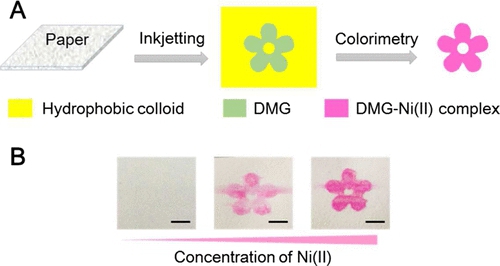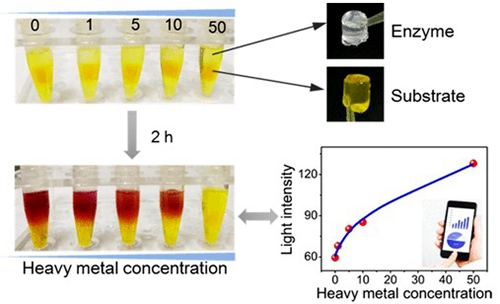Heavy metals can interact strongly with proteins, enzymes, etc. in the human body, making them inactive or accumulating in certain organs of the body, causing chronic poisoning. Therefore, the detection and toxicity assessment of heavy metals is of great significance. Traditional heavy metal ion detection methods rely on large instruments, which are cumbersome and time consuming, and thus are not suitable for on-site inspection.
Recently, the research group led by Prof. HE Junhui at Technical Institute of Physics and Chemistry of Chinese Academy of Sciences has designed a superwettable paper–based analytical device for heavy metal ion detection. Firstly, the high-precision superwettable pattern was produced by the inkjet printing method, and then the paper–based analytical device was fabricated by inkjet printing the probe molecules in the superwettable pattern. In the actual detection process, the paper–based analytical device only needs to be placed in the water sample to be tested, and the visual analysis of heavy metal ions in the water sample can be realized according to the color change.

Superwettable paper–based analytical device for visualized heavy metal ion detection.
Moreover, the research group has also developed a method for assessing the toxicity of heavy metal ions using biological enzymes. Because heavy metal ions have a significant inhibitory effect on the biological enzyme, the total toxicity evaluation of heavy metal ions in the water sample is achieved by enzymatic color reaction. Encapsulation of biological enzymes by hydrogel not only improves the long-term validity of biological enzymes, but also further simplifies the practical analytical steps.

Colorimetric total toxicity assessment of heavy metal ions.
These efforts laid the foundation for the development of portable heavy metal ion detection kits. These works were recently published in ACS Applied Materials & Interfaces (2018, 10, 11343–11349;2018, 10, 26705–26712).
Link:https://pubs.acs.org/doi/10.1021/acsami.8b01133;https://pubs.acs.org/doi/10.1021/acsami.8b08949;
E-mail: zhangyue@mail.ipc.ac.cn
NEWS